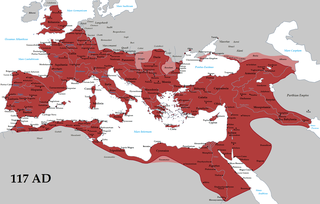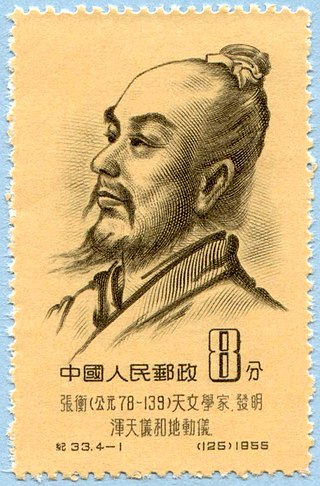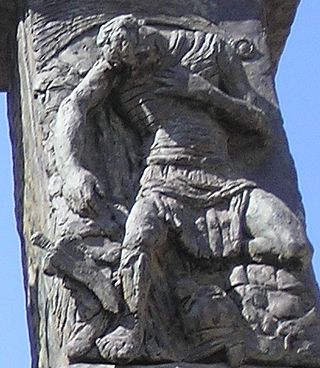
Simon bar Kokhba or Simon bar Koseba, commonly referred to simply as Bar Kokhba, was a Jewish military leader in Judea. He lent his name to the Bar Kokhba revolt, which he initiated against the Roman Empire in 132 CE. Though they were ultimately unsuccessful, Bar Kokhba and his rebels did manage to establish and maintain a Jewish state for about three years after beginning the rebellion. Bar Kokhba served as the state's leader, crowning himself as nasi. Some of the rabbinic scholars in his time imagined him to be the long-expected Messiah of Judaism. In 135, Bar Kokhba was killed by Roman troops in the fortified town of Betar. The Judean rebels who remained after his death were all killed or enslaved within the next year, and their defeat was followed by a harsh crackdown on the Judean populace by the Roman emperor Hadrian.

The 2nd century is the period from AD 101 through AD 200 (CC) in accordance with the Julian calendar. It is considered part of the Classical era, epoch, or historical period.

The 70s was a decade that ran from January 1, AD 70, to December 31, AD 79.

The 110s was a decade that ran from January 1, AD 110, to December 31, AD 119.

The 120s was a decade that ran from January 1, AD 120, to December 31, AD 129.

Year 125 (CXXV) was a common year starting on Sunday of the Julian calendar. At the time, it was known as the Year of the Consulship of Paullinus and Titius. The denomination 125 for this year has been used since the early medieval period, when the Anno Domini calendar era became the prevalent method in Europe for naming years.
AD 9 (IX) was a common year starting on Tuesday of the Julian calendar. In the Roman Empire, it was known as the Year of the Consulship of Sabinus and Camerinus. The denomination "AD 9" for this year has been used since the late medieval period, when the Anno Domini calendar era became the prevalent method in Europe for naming years.
AD 71 (LXXI) was a common year starting on Tuesday of the Julian calendar. At the time, it was known as the Year of the Consulship of Vespasian and Nerva. The denomination AD 71 for this year has been used since the early medieval period, when the Anno Domini calendar era became the prevalent method in Europe for naming years.
AD 75 (LXXV) was a common year starting on Sunday of the Julian calendar. At the time, it was known as the Year of the Consulship of Augustus and Vespasianus. The denomination AD 75 for this year has been used since the early medieval period, when the Anno Domini calendar era became the prevalent method in Europe for naming years.
AD 76 (LXXVI) was a leap year starting on Monday of the Julian calendar. At the time, it was known as the Year of the Consulship of Titus and Vespasianus. The denomination AD 76 for this year has been used since the early medieval period, when the Anno Domini calendar era became the prevalent method in Europe for naming years.
AD 89 (LXXXIX) was a common year starting on Thursday of the Julian calendar. At the time, it was known as the Year of the Consulship of Fulvus and Atratinus. The denomination AD 89 for this year has been used since the early medieval period, when the Anno Domini calendar era became the prevalent method in Europe for naming years.

The 130s was a decade that ran from January 1, 130, to December 31, 139.
Year 115 (CXV) was a common year starting on Monday of the Julian calendar. In the Roman Empire, it was known as the Year of the Consulship of Messalla and Vergilianus. The denomination 115 for this year has been used since the early medieval period, when the Anno Domini calendar era became the prevalent method in Europe for naming years.
Year 120 (CXX) was a leap year starting on Sunday of the Julian calendar. At the time, it was known as the Year of the Consulship of Severus and Fulvus. The denomination 120 for this year has been used since the early medieval period, when the Anno Domini calendar era became the prevalent method in Europe for naming years.
Year 135 (CXXXV) was a common year starting on Friday of the Julian calendar. At the time, it was known as the Year of the Consulship of Lupercus and Atilianus. The denomination 135 for this year has been used since the early medieval period, when the Anno Domini calendar era became the prevalent method in Europe for naming years.

Legio XXII Deiotariana was a legion of the Imperial Roman army, founded ca. 48 BC and disbanded or destroyed during the Bar Kokhba revolt of 132–136. Its cognomen comes from Deiotarus, a Celtic king of Galatia. Its emblem is unknown.

The Bar Kokhba revolt was a large-scale armed rebellion initiated by the Jews of Judea, led by Simon bar Kokhba, against the Roman Empire in 132 CE. Lasting until 135 or early 136, it was the third and final escalation of the Jewish–Roman wars. Like the First Jewish–Roman War and the Second Jewish–Roman War, the Bar Kokhba revolt resulted in a total Jewish defeat; Bar Kokhba was killed by Roman troops at Betar in 135, and the Jewish rebels who remained after his death were all killed or enslaved within the next year.

The Kitos War was a Jewish uprising in the province of Judaea during the late 110s CE. Ancient Jewish sources date it to 52 years after Vespasian's war and 16 years before the Bar Kokhba revolt (132–136).

Legio V Macedonica was a Roman legion. It was probably originally levied in 43 BC by consul Gaius Vibius Pansa Caetronianus and Gaius Julius Caesar Octavianus. It was based in the Balkan provinces of Macedonia, Moesia and Dacia. In the Notitia Dignitatum records from beginning of the fifth century, the legion was still stationed in Dacia, with detachments stationed in the east and Egypt.
The administration of Judaea as a province of Rome from 6 to 135 was carried out primarily by a series of Roman Prefects, Procurators, and Legates pro praetore. These administrators coincided with the ostensible rule by Hasmonean and Herodian rulers of Judea. The Roman administrators were as follows:









